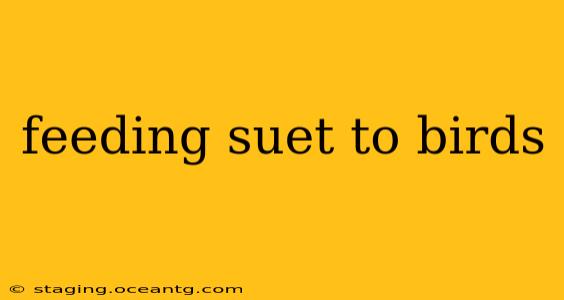Suet, that rich, energy-packed fat, is a wintertime favorite for many backyard birds. Offering suet provides a crucial energy boost during cold snaps when natural food sources are scarce. But choosing the right suet, placing it strategically, and understanding potential downsides are all key to successful suet feeding. This comprehensive guide will cover everything you need to know about providing this nutritious treat to your feathered friends.
What is Suet and Why is it Good for Birds?
Suet is essentially rendered beef fat, although nowadays you can find suet made from other fats, including vegetable-based options. Its high-calorie density makes it an ideal energy source, especially crucial for smaller birds during cold weather. The fat content helps birds maintain body temperature and provides essential nutrients for survival. Many commercially available suet cakes also include seeds, nuts, and dried fruits, adding further nutritional value and attracting a wider variety of bird species.
What Kinds of Birds Eat Suet?
A wide range of bird species enjoy suet, including woodpeckers (downy, hairy, and pileated), nuthatches, chickadees, titmice, jays, and even some larger birds like cardinals and robins. The specific birds attracted will depend on your location and the type of suet offered. Suet containing insects or mealworms will particularly appeal to insectivorous birds.
How to Choose the Right Suet for Birds?
Choosing the right suet involves considering several factors:
- Ingredients: Look for suet with high-quality ingredients. Avoid products with fillers or excessive amounts of grain. Pure suet is ideal, but blends with nuts, seeds, and dried fruits can enhance attractiveness to birds.
- Type: Suet comes in various forms: cakes, logs, nuggets, and even in feeders designed to dispense it. Choose a type that suits your preference and feeder style.
- Quality: Opt for suet from reputable brands, ensuring the product is fresh and free from mold or rancidity. Check the expiration date if available.
- Insect Content: Consider insect-based options to appeal to a broader variety of birds that appreciate protein in their diet.
What is the Best Way to Feed Suet to Birds?
The best way to feed suet depends on your local bird species and your personal preference. Common options include:
- Suet Cakes: These are easily purchased and placed in mesh feeders.
- Suet Logs: These are often larger and longer-lasting.
- Suet Feeders: Many specialized feeders are designed to hold suet, helping to keep it away from squirrels and other unwanted visitors. Look for feeders with cages or protective barriers around the suet.
Where Should I Place a Suet Feeder?
Strategic placement of your suet feeder is crucial for attracting birds and deterring predators:
- Location: Place the feeder in a visible but sheltered location, away from direct sunlight, rain, and wind.
- Height: Hang the feeder at least 4-5 feet above the ground to protect it from ground predators like cats and raccoons.
- Visibility: Ensure the feeder is easily accessible to birds, with plenty of nearby perches.
- Protection: Consider adding some form of predator protection, especially if you have common predators in your area.
How Often Should I Refill My Suet Feeder?
The frequency of refilling depends on the size of your feeder, the number of birds visiting, and the weather conditions. During cold weather or when many birds are present, you may need to refill daily or every other day. Check regularly to ensure the suet isn't depleted and to prevent spoilage.
Can Suet Harm Birds?
While generally safe, suet can present some potential drawbacks:
- Spoilage: Rancid suet can be harmful to birds. Always use fresh suet and dispose of spoiled suet promptly.
- Attracting Unwanted Animals: Squirrels, raccoons, and other animals may be attracted to suet, so use feeders designed to deter them.
- Overfeeding: While offering a valuable energy source, overfeeding birds can lead to health problems. Aim for moderation and provide a diverse range of food sources.
What are Some Alternatives to Suet?
While suet is a popular and effective choice, other high-energy foods can supplement or replace it:
- Peanut Butter: Unsalted peanut butter, diluted with cornmeal or oats, can be a great alternative. Avoid products containing xylitol, which is toxic to birds.
- Nuts: Shelled peanuts, sunflower seeds, and other nuts offer protein and energy.
- Seeds: Sunflower seeds, niger seeds, and other bird seeds provide additional nutrients.
By following these guidelines, you can provide a safe and nutritious source of energy for your local birds while enjoying the pleasure of observing them in your backyard. Remember that responsible suet feeding is key to benefiting both the birds and your own enjoyment of nature.
